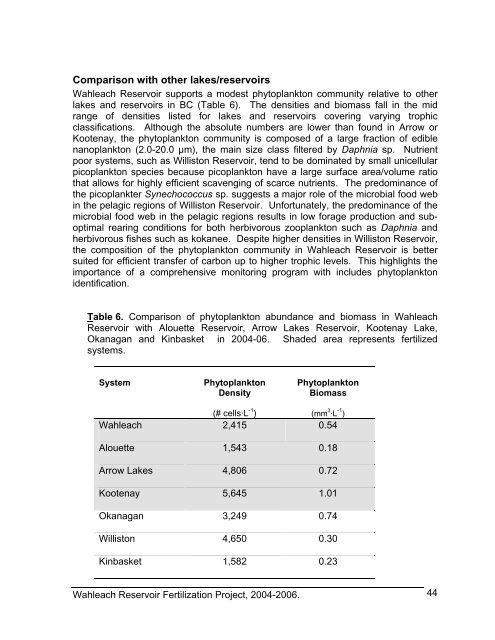Wahleach Project Water Use Plan Wahleach Reservoir ... - BC Hydro
Wahleach Project Water Use Plan Wahleach Reservoir ... - BC Hydro
Wahleach Project Water Use Plan Wahleach Reservoir ... - BC Hydro
Create successful ePaper yourself
Turn your PDF publications into a flip-book with our unique Google optimized e-Paper software.
Comparison with other lakes/reservoirs<br />
<strong>Wahleach</strong> <strong>Reservoir</strong> supports a modest phytoplankton community relative to other<br />
lakes and reservoirs in <strong>BC</strong> (Table 6). The densities and biomass fall in the mid<br />
range of densities listed for lakes and reservoirs covering varying trophic<br />
classifications. Although the absolute numbers are lower than found in Arrow or<br />
Kootenay, the phytoplankton community is composed of a large fraction of edible<br />
nanoplankton (2.0-20.0 µm), the main size class filtered by Daphnia sp. Nutrient<br />
poor systems, such as Williston <strong>Reservoir</strong>, tend to be dominated by small unicellular<br />
picoplankton species because picoplankton have a large surface area/volume ratio<br />
that allows for highly efficient scavenging of scarce nutrients. The predominance of<br />
the picoplankter Synechococcus sp. suggests a major role of the microbial food web<br />
in the pelagic regions of Williston <strong>Reservoir</strong>. Unfortunately, the predominance of the<br />
microbial food web in the pelagic regions results in low forage production and suboptimal<br />
rearing conditions for both herbivorous zooplankton such as Daphnia and<br />
herbivorous fishes such as kokanee. Despite higher densities in Williston <strong>Reservoir</strong>,<br />
the composition of the phytoplankton community in <strong>Wahleach</strong> <strong>Reservoir</strong> is better<br />
suited for efficient transfer of carbon up to higher trophic levels. This highlights the<br />
importance of a comprehensive monitoring program with includes phytoplankton<br />
identification.<br />
Table 6. Comparison of phytoplankton abundance and biomass in <strong>Wahleach</strong><br />
<strong>Reservoir</strong> with Alouette <strong>Reservoir</strong>, Arrow Lakes <strong>Reservoir</strong>, Kootenay Lake,<br />
Okanagan and Kinbasket in 2004-06. Shaded area represents fertilized<br />
systems.<br />
System<br />
<strong>Wahleach</strong><br />
Alouette<br />
Arrow Lakes<br />
Kootenay<br />
Okanagan<br />
Williston<br />
Kinbasket<br />
Phytoplankton<br />
Density<br />
Phytoplankton<br />
Biomass<br />
(# cells·L -1 ) (mm 3 ·L -1 )<br />
2,415<br />
0.54<br />
1,543 0.18<br />
4,806 0.72<br />
5,645 1.01<br />
3,249 0.74<br />
4,650 0.30<br />
1,582 0.23<br />
<strong>Wahleach</strong> <strong>Reservoir</strong> Fertilization <strong>Project</strong>, 2004-2006.<br />
44
















